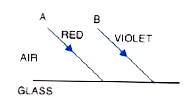Is the temperature of air in the closed glass vessel/bottle the same as the temperature taken in open air? (i) What do you think is the reason for this? (ii) Do we ever come across this phenomenon in daily life?
Step-by-Step Solution:
1. Understanding the Experiment: In the experiment, three glass vessels are used: one with water, one with sand, and one empty (containing only air). All three are placed in sunlight for a few hours.
2. Measuring Temperature: After exposure to sunlight, the temperature of each vessel is measured using a thermometer. This helps us understand how different materials absorb and retain heat.
3. Observations:
- Water takes a long time to heat up and cool down.
- Sand heats up and cools down quickly.
- The air in the empty vessel also behaves differently compared to the other two.
4. Comparing Temperatures: When comparing the temperature of air in a closed glass vessel to the temperature of air in the open environment, it is observed that the temperature in the closed vessel is higher.
5. Reason for Temperature Difference: The reason for this difference is the greenhouse effect. Sunlight enters the glass vessel and gets trapped inside because the glass does not allow all the heat to escape. This leads to a higher temperature inside the vessel compared to the open air.
6. Real-Life Phenomenon: This greenhouse effect is not only observed in glass vessels but also in our atmosphere. The atmosphere acts like a blanket, trapping some of the sun's energy and maintaining a stable temperature on Earth, which is essential for the survival of living organisms.
- Water takes a long time to heat up and cool down.
- Sand heats up and cools down quickly.
- The air in the empty vessel also behaves differently compared to the other two.
Topper's Solved these Questions
- NATURAL RESOURCESBOOK - NCERT ENGLISHCHAPTER - NATURAL RESOURCESEXERCISE - EXERCISE
20 Videos
- NATURAL RESOURCESBOOK - NCERT ENGLISHCHAPTER - NATURAL RESOURCESEXERCISE - Questions
1 Videos
- IMPROVEMENT IN FOOD RESOURCESBOOK - NCERT ENGLISHCHAPTER - IMPROVEMENT IN FOOD RESOURCESEXERCISE - Exercise
26 Videos
- THE FUNDAMENTAL UNIT OF LIFEBOOK - NCERT ENGLISHCHAPTER - THE FUNDAMENTAL UNIT OF LIFEEXERCISE - All Questions
18 Videos
Similar Questions
Is the thermometer reading of the temperature of air (in shade) the same as the temperature of sand or water? What do you think is the reason for this? And why does the temperature have to be measured in the shade?
View SolutionTwo ideal gas thermometer A and B use oxygen and hydrogen respectively . The following observations are made:
Temperature, Pressure therometer A, Pressure therometer B
Triple point of water, 1.250×105Pa, 0.200×105Pa
Normal melting point of sulphur, 1.797×105Pa, 0.287×105Pa
(a) What is the absolute temperature of normal melting point of sulphur as read by thermometers A and B ?
(b) What do you think is the reason for the slightly different answers from A and B ? (The thermometers are not faulty). what further procedure is needed in the experiment to reduce the discrepancy between the two readings.
View SolutionTwo closed vessels of equal volume containing air at pressure P1 and temperature T1 are connected to each other through a narrow tube. If the temperature in one of the vessels is now maintained at T1 and that in the other at T2, what will be the pressure in the vessels?
View SolutionTwo closed vessels of equal volume containing air at pressure P1 and temperature T1 are connected to each other through a narrow tube. If the temperature in one of the vessels is now maintained at T1 and that in the other at T2, what will be the pressure in the vessels?
View Solution(i) A conducting cylinder whose inside diameter is 4.00cm contains air compressed by a piston of mass m=13.0kg, which can slides freely in the cylinder shown in the figure. The entire arrangement is immersed in a water bath whose temperature can be controlled. The syetem is initially in equilibrium at temperature t1=20∘C. The initial height of the piston above the bottom of the cylinder is hi=4.00cm.Patm=1×105Nm2 and g=10m/s2.
If the temperature of the water bath is gradually increased to a final temperature tf=100∘C. Find teh height hf of the piston (in cm) at that instant?
(ii) In the above question, if we again start from the initial conditions and the temperature is again gradually raised, and weights are added to the piston to keep its height fixed at hi. Find the value of teh added mass when the final temperature becomes tf=100∘C?

View SolutionAn air column in a glass tube , is open at one end and closed at the other by a movable piston . The air in the tube is warmed above room temperature , and a 384Hz tuning fork is held at the open end. Resonance is heard when the piston is 22.8cm from the open end and again when it is 68.3cm from the open end . (a) What speed of sodium is impliedby these data ? (b) How far from the open end will the piston be when the next resonance is heard ?
View SolutionThe diagram below shows two parallel rays A and B of red and violet light respectively incident from air on air-glass boundary. Complete the diagram showing the refracted rays for them in the glass.

(i) How do the speeds of the rays differ in glass ?
(ii) are the two refracted rays in glass parallel ?
Give a reason for your answer.
(iii) How does the refractive index of glass differ for the two rays ?
View SolutionA 1-L flask contains some mercury. It is found that at different temperature, the volume of air inside the flask remains the same. What is the volume of mercury in the flask, given that the coefficient of linear expansion of glass=9×10−6/∘C and the coefficient of volume expansion of Hg=1.8×10−4/∘C ?
View SolutionA 1-L flask contains some mercury. It is found that at different temperature, the volume of air inside the flask remains the same. What is the volume of mercury in the flask, given that the coefficient of linear expansion of glass=9×10−6/∘C and the coefficient of volume expansion of Hg=1.8×10−4/∘C ?
View SolutionWhat is the fundamental frequency of vibration of air in (i) an open pipe and (ii) a closed pipe.
View Solution
